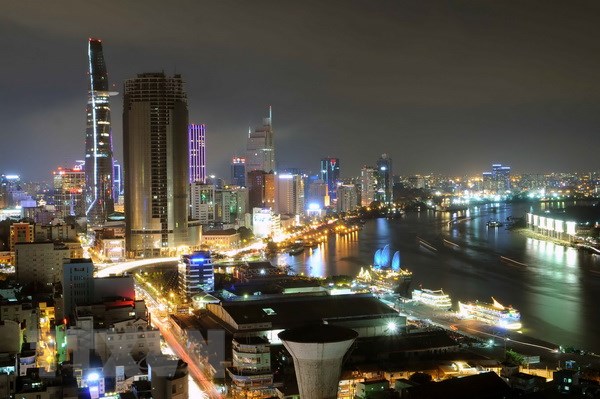Smart city challenges Gov’t and localities
2019/10/07

A corner of HCM City. The city is applying technology solutions to become a smart city in the future. — VNA/VNS Photo An Hiếu
HÀ NỘI — In efforts to embrace the fourth industrial revolution (Industry 4.0), cities and provinces in Việt Nam are pushing smart city programmes, combining technology with internet-connected devices to enhance municipal management and economy.
Smart cities, with new technologies and integration based on sensor collection and analysis of data, are expected to drive economic, environmental and social benefits in many cities and provinces in Việt Nam – optimising traffic flows in real time, reducing energy consumption and automating waste management.
However, despite the countless benefits of smart city projects, major cities including Hà Nội and HCM City, which are pioneering in this field, are facing difficulties and challenges when it comes to deployment due to city-specific requirements and needs of new policies and regulations from the Government and relevant sectors.
Speaking at the Industry 4.0 summit held in Hà Nội last week, Deputy Chairman of HCM City Trần Vĩnh Tiến said the city had been building its smart city project for two years with consultation from VNPT and Viettel Group. The city has gathered experience from many cities around the world and discovered that smart cities are different.
“From East Asia to South Asia, from the US to Europe, all smart cities are different. We are advised that we should conduct a smart city project suited to the characteristics of the city because the application of Industry 4.0 will solve specific problems of each city such as traffic congestion, flooding and environmental pollution,” Tiến said.
However, to develop it, Tiến said the city would need an information centre allowing interaction among local authorities, businesses and people. In which, the State and businesses would be able to exploit each other’s data while people could share contributions and ideas. All of these interaction must be digital.
Therefore, the Government should build a legal corridor for data management soon.
“The data area is even more important than land. If we want to manage the data area effectively and synchronously we need to have a legal corridor.”
Tiến also proposed the Government set up a smart city architectural blueprint for all cities and provinces nationwide, ensuring synchronisation – which is the most basic principle of technology – and efficiency.
“In addition, as the Government has approved the digitalisation project, we want to volunteer. If we do not digitalise, technology of the city will be not effective,” Tiến added.
According to Deputy Chairman of Hà Nội People’s Committee Ngô Văn Quý, Hà Nội is building an e-government and smart city. It has achieved some initial results in the construction of information infrastructure, applying corporate information, State management and residential data, moving towards a smart city model, including smart transport and travel.
“During the implementation process, there are several problems that need to be solved. We lack standards relevant to the building of e-government and smart cities. The Ministry of Information and Communications (MIC) has developed this content, but it is not yet completed. It should be issued as soon as possible,” Quý said.
Regarding information application, Quý wanted the Government to build software for localities from the central to the grassroots level. “If each locality researches and develops their own software, it is wasteful while causing difficulties in integration and connectivity. Recently, I saw some very good implementations, such as corporate management software of the Ministry of Planning and Investment and software to manage drugstore and pharmacies of the Ministry of Health.”
Technology solutions are just a part of the smart city programme, Quý said, adding that the capital city is facing shortages in human resources. The general trend of qualified information technology (IT) staff is moving to work for non-State enterprises, which pay a higher salary.
“We expect the State to have special policies to encourage IT staff to work for the State management agencies, building e-government and smart cities,” Quý said.
According to the Ministry of Information and Communication (MIC), smart cities are the basic driving force for socio-economic development of the nation and regions across the country. Việt Nam has more than 830 urban areas with the urbanisation rate of 38.6 per cent.
Economic growth in urban areas averages 12-15 per cent, 1.5-2 times higher than the national average. About 30 cities and provinces nationwide have implemented smart urban construction projects, including HCM City and Hà Nội.
However, according to MIC the current development of smart cities is still inadequate. Some localities have started deploying some basic applications and services for smart cities. Meanwhile, ministries and agencies continue to research and complete building guidelines, mechanisms and policies for smart cities.
Deputy Minister of MIC Nguyễn Thành Hưng asked localities to see the development of e-government as a key factor to building smart cities, in addition to ensuring cyber security.
“We should select capable businesses to organise the implementation of smart city projects. Lastly, it’s essential to develop human resources suitable for a smart city. It is indispensable for leaders who have decisive vision and qualified human resources to operate technology solutions in smart cities,” Hưng said. — VNS
